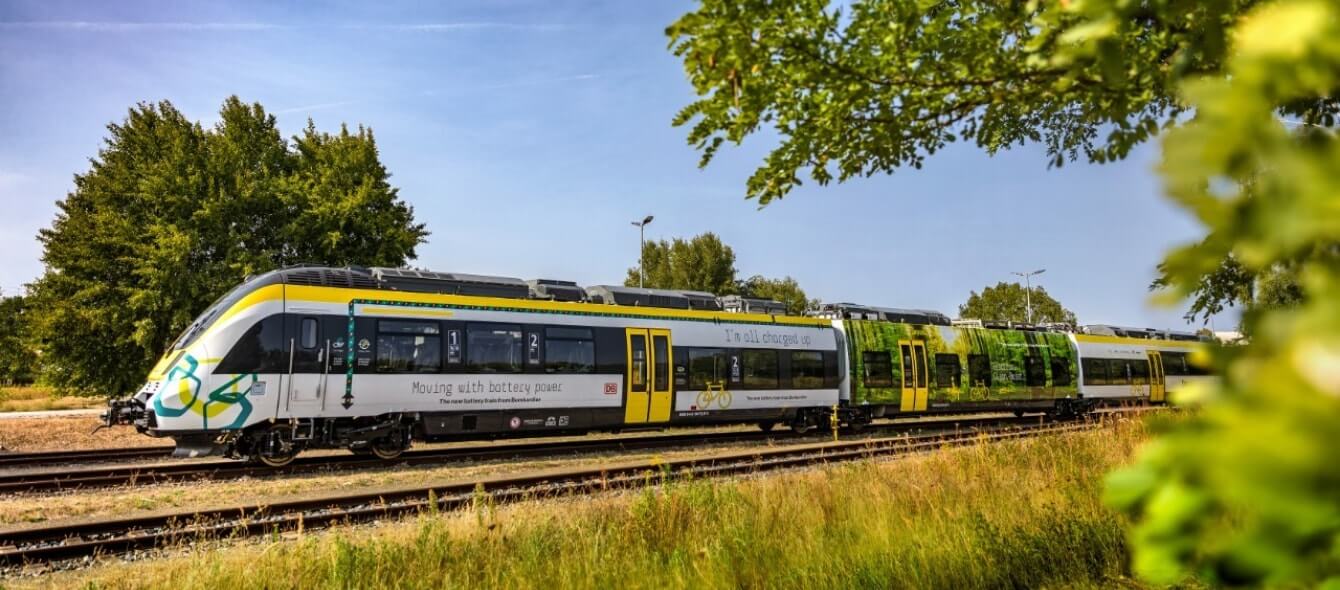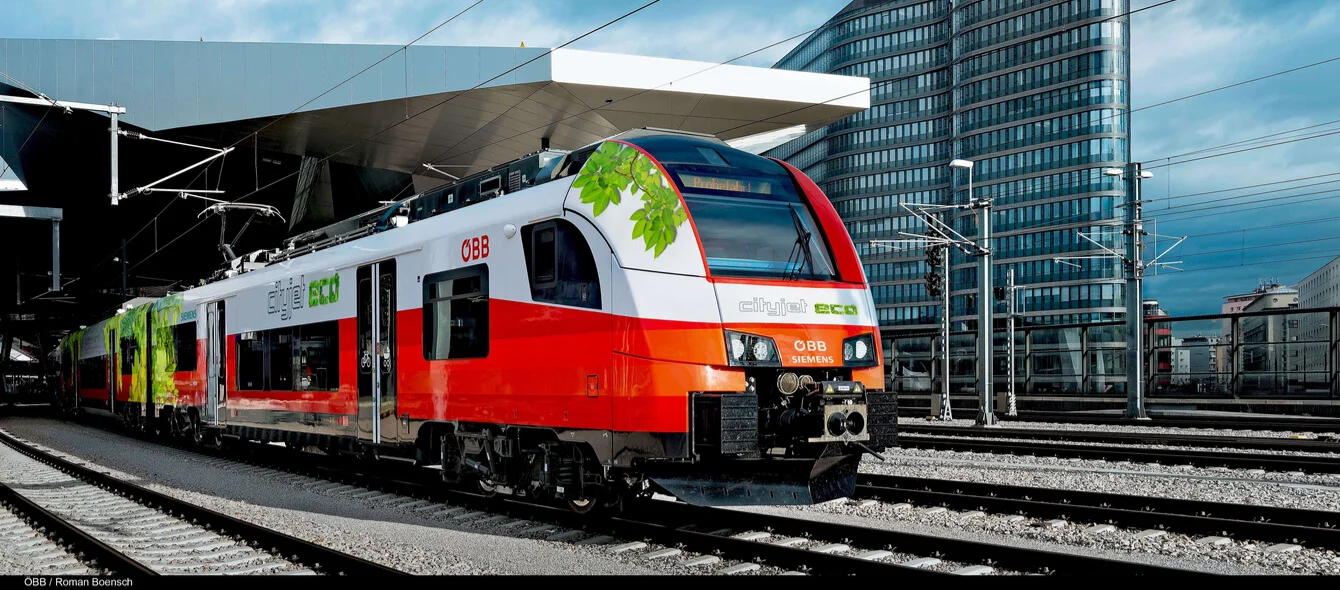Train travel is considered to be an environmentally friendly, i.e. a ‘green’ way of travelling. “Rail travel is tangible climate protection”, explains railway boss Richard Lutz. Since 1 January 2018, Deutsche Bahn’s long-haul trains have been running on certified green electricity and by 2050, the freight and local trains will be, too. However, not every train is electrically powered, and not every kilometre of railway has an overhead line. To date, 40 percent of the German rail network is yet to be electrified. This includes both shorter sections of just a few kilometres as well as sections of 100 kilometres and more. Around 1,300 diesel trains are still in use throughout Germany.
According to the latest transport statistics survey from 2015, only 20,726 out of 38,466 railway kilometres have been electrified so far. The Allianz Pro Schiene association has calculated that in federal states such as Schleswig-Holstein and Thuringia less than one third of the rail network has been equipped with overhead contact lines. Although Germany as a whole is just above the EU average rate of 54 percent electrification, it is still lagging well behind countries such as Sweden, the Netherlands, Belgium and Switzerland which boast rates of 75 to 100 percent.
Railways with overhead lines in Europe 2016
Proportion in percent, selected European countries (Source: Allianz pro Schiene 2018)Every five years, data is collected on route lengths as well as the degree of electrification of the rail infrastructure. According to the federal government, the rate of electrification in Germany will have increased to 70 percent by 2025. But what is going to happen on the remaining routes? And what can be done about the fact that sometimes diesel-powered trains still have to be used under overhead lines because it is simply too time-consuming or just not possible to switch to more eco-friendly trains?
World’s first hydrogen train in regular service
Alternative drive options are all the rage at the minute. Several companies are therefore working on solutions for trains that are not exclusively dependent on overhead contact lines. The world’s first hydrogen train has been in regular operation since September 2018 on the route between Cuxhaven and Buxtehude, in Lower Saxony and Bremen. The Coradia iLint model is made by the French manufacturer Alstom and is based on a diesel model that has been in use for over 20 years.
The new, bright blue regional train can accelerate up to 140 kilometres per hour, can accommodate a total of 300 passengers and has a range of 1,000 kilometres, which corresponds to one operating day. It is significantly quieter than a diesel-powered train and emits only water vapor. However, its operation is only carbon-neutral if the necessary hydrogen is produced with renewables. Lower Saxony’s Economics and Transport Minister Bernd Althusmann sees the hydrogen train as “a climate-friendly alternative to conventional diesel trains, especially on non-electrified lines”.
The train is currently refuelled via a mobile filling unit, which is located in a station next to the tracks and pumps hydrogen into a tank on the train roof. By 2021, the Lower Saxony State Transport Authority (LNVG) wants to operate a permanently installed hydrogen filling station, so that it will be possible to refuel the 14 other hydrogen trains that have already ordered. North Rhine-Westphalia, Baden-Württemberg and the Frankfurt-based Rhine-Main Transport Association have also expressed an interest in the new train model, as have several EU member states, Norway and Canada.
Both Siemens Mobility and Bombadier are developing battery-powered trains
In the latter half of 2019, Siemens Mobility, together with the Austrian Federal Railway (ÖBB), plans to test a train with an electro-hybrid battery drive that will emit 50 percent less carbon dioxide than a diesel engine. The train, known as Desiro ML Cityjet eco, is to be supplied with energy via its current collector when on electrified lines, and it will then store said energy in the 14-tonne batteries it carries for the sections without overhead lines. It will be able to travel up to 80 kilometres with the energy from the batteries and the technology will be tested in Lower and Upper Austria.
Bombardier Transportation is taking the same approach with its Talent 3 drive wagon, which is to be used to bridge routes without overhead lines. Last September during its maiden voyage, Enak Ferlemann, State Secretary in the Federal Ministry of Transport and Federal Government Commissioner for Rail Transport, described the battery train as being “pure innovation” and a “giant step” in the right direction to further electrification of rail traffic.
Bombardier’s electric trains go battery
Similar to the Siemens Mobility model, it charges its batteries while running under overhead lines and is then able to use the stored energy on routes without electricity. Around half of these routes are shorter than 70 kilometres in length. Although the battery-powered train is still only able to manage 40 kilometres, this figure is set to rise to 100 in the future. The Talent 3 is to be tested in the public transport network of the Alb-Bodensee region of Baden-Württemberg before the end of this year.
Deutsche Bahn converts diesel trains
While others are developing new electric trains, Deutsche Bahn is focusing primarily on retrofitting existing diesel locomotives. The reason for this is that many diesel trains are still fairly new. “Existing vehicles should not be scrapped before their normal lifespan of at least 30 years.” The idea is to create a kind of modular principle for “modern, flexible hybrid vehicles”. For example, its DB RegioNetz subsidiary is testing alternative drive systems for its diesel trains. So far, there are three different versions of what are referred to as the ‘EcoTrains’.
The basic model of the EcoTrain HybridMode comes with a diesel engine and a battery. The energy storage system enables electric travel for distances of up to 40 kilometres. EcoTrain HybridModes are currently being converted in Saxony. “The necessary improvements of the hybrid vehicle, which included a new hybrid drive module, energy module, modified bogies and a stationary recharging option with 1,000 volts, have largely been achieved,” explains railway spokesman Hartmut Sommer. Over the coming year, the project could receive official approval from the Federal Railway Authority.
The second new model, the EcoTrain DualMode, is additionally equipped with a pantograph for driving and recharging beneath a contact wire. According to Sommer, the third variant, the EcoTrain eMode, does away with a diesel engine entirely: “It has twice the storage capacity and can therefore operate on non-electrified sections of up to 80 kilometres when in battery mode.”

